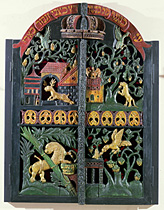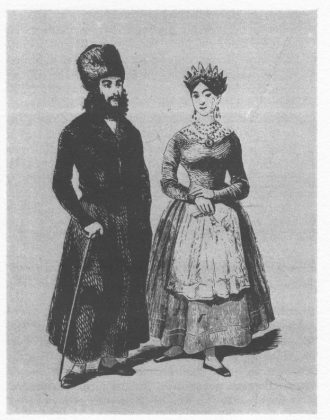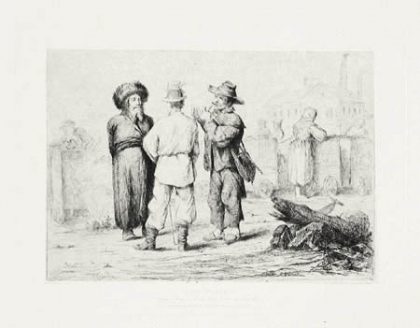
Poland represents the most illustrious and tragic chapter in European Jewish history. For centuries, this country was the most welcoming to Jews fleeing Germany, Spain, and southern Europe; the continent largest Jewish community was born here, enjoying privileges and autonomy granted by the different kings and developing an incredibly rich culture of its own. Ultimately, however, Poland wound up the largest cemetery in Europe, the place where the Nazi dream of “exterminating the Jewish race” was almost perfectly realized. Two numbers are enough to grasp the magnitude of the disaster: there were 3500000 Jews in Poland in 1939, or 10% of the population; a maximum of 2000 to 3000 live here today. Touring Jewish Poland resembles an archaeological dig conducted after a Pompeii-style cataclysm, a search for traces of a lost civilization alive today only in literature and the memories of those who emigrated in time or miraculously survived.
The earliest remnant of a Jewish presence in Poland dates to the tenth century: a traveler from Toledo, Ibrahim ibn Jacob, wrote the first major report dealing with Poland in 965. In 1098, during the Crusades, Jews expelled from Prague settled in Poland. Jewish communities were mentioned in Plock in 1237, Kalisz in 1287, and Kraków in 1304. In 1264, the king of Poland, Boleslas the Pious, issued the “Kalisz statute”, which guaranteed Jews religious freedom and security of person and property. In the fourteenth century, under Casimir the Great, these privileges were reaffirmed in 1364 and 1367, and then once more in 1453 by Casimir Jagiello; they remained effective for Jews until Poland was divided in the late eighteenth century. Jewish communities here were virtually autonomous, enjoying the right to dispense justice and build synagogues and schools, making Poland the most tolerant country to Jews in Europe.
Starting in the mid-sixteenth century, Jewish exiles from Germany found refuge in Poland. Jewish quarters began forming in Lvov (1356), Sandormierz (1367), and Kazimierz near Kraków (1386); in all, communities were reported in eighty-five cities. Refugees continued flowing in throughout the sixteenth and early seventeenth centuries not simply from the Germanic countries but also from Spain, Italy, and Turkey. Centers of Jewish life began shifting eastward through the country.

In 1581, the first “Diet of the Four Countries” convened in Lublin (Sejm Czerterech Ziem, or in Hebrew Vaad arba aratsot) and continued to meet every year until 1764. The Sejm, or Vaad, governed the Jewish communities of Poland and Lithuania: it issues ruling , collected taxes, and worked to protect the community. It was the Vaad that voted to erect fortified synagogues in Brody, Buchach, Lesko, Lublin, Shargorod, Stryy, Szczebrzeszyn, Zamosc, Zólkiew, and other towns. In 1648, the Jewish populqtion on Poland was estimated at 500000 inhabitants, or already 5% of the total population.
A fifth of Poland4s jews were massacred by the Cossacks under Bohdan Khmelnitsky. The Hasidic religious revitalization movement was born and flourished in Poland and Ukraine as an indirect consequence of these massacres and of the impoverishment of those who survived them. Jews would have to wait until the eighteenth century for their communities to form again and grow. In 1790, after the first division of Poland, Their number reached about 900000, or 10% of the population.
From 1795 to 1918, Poland was erased from the map, split between the three neighboring powers (Russia, Austria, Prussia), except during the years 1807-15, at which time Napoleon created the Grand Duchy of Warsaw. The vast majority of Jewish communities in Poland found themselves under the Russian Empire and so lost all the privileges they had enjoyed during the Polish era. Community self-governance was suppressed, as the czar relegated the Jewish population to the Pale of Settlement and imposed other serious restrictions on them. A large proportion of Jews also lived in the section of Poland annexed by Austria (Galicia); though they did at first see some of the privileges abolished, they benefited from favorable local governments in certain cities. From 1867 to 1868, all subjects under the Austrian monarchy, including Jews, were granted equal rights. In Galicia the assimilation of Jews was greatest: a number of Jewish intellectuals turned toward German culture, such as Karl-Emil Franzos (born in Czortkov) and Joseph Róth (born in Brody), while others embraced Polish culture, such as Bruno Schultz (born in Drohobych).
After the First World War, an independent Poland was re-created with enlarged eastern borders containing “borderlands” (kresy) In Galicia, Volhynia, Belarus, and Lithuania.

The “Jewish question” was increasingly posed: this was not merely a national and religious question but a social one, considering the teaming, poverty-stricken masses that lived in Poland’s ghettos. The Polish government between the wars, dominated by anti-Semitic National Democracy, burdened them with taxes and prevented their social ascent. Tensions were mounting, and when the “rising threat” and German occupation arrived, the Jews were slowly but surely abandoned by the Poles, themselves subject to severe repression and concerned with their own survival.
What followed is too well-known to be related here in detail. On 1 September 1939, the Germans invaded Poland and created ghettos in which they gathered together the Jewish population, strictly separating the Jews from the “Aryan” districts and imposing sweeping restrictions aimed at exhausting them through work and lack of food.
Starting in 1941 and throughout 1942, the ghettos were liquidated one by one, their populations transferred to newer camps in Chelmno, Belzec, Sobibor, and Treblinka explicitly designed for extermination, or to already existing ones like Auschwitz or Majdanek, set up both for labor and extermination. The entire Jewish population of Poland, with few exceptions, perished in these death camps. The best known of all the camp is Auschwitz, today the symbol of the Shoah. It was there that the industry of death was taken to its extreme. However, we will only touch on Auschwitz in this guide, precisely because its history is so well-known and because it is too much visited and so depressing. We have chosen to stop at Poland’s more beautiful sites, to discover and tour with pleasure and emotion places like Kraków, Lesko, Zamosc, and Lublin, and to present lesser known but equally moving camps like Sobibor, Treblinka, and Chelmno, where a visitor can reflect more easily that among the throngs of tourists at Auschwitz.
The postwar history of Poland’s Judaism demonstrated once again misunderstandings between Jews and Poles. Besides the rare survivors of the ghettos, the only other Jews still living were soldiers in the Soviet zone who had joined the Red Army and participated in their country’s liberation. When they returned, they found the ghettos deserted, their homes destroyed, their relatives all extermined. The first wave of emigrants to Israel began, growing in 1947 after the Kielce pogrom. Every jolt of Polish nationalism or national-Communism from then on provoked new waves of Jewish emigration, notably on 1956 with Gomulka’s arrival to power, and in 1967 and 1968 after the Six Days War. This tide of emigration almost completely emptied the country of its Jewish population: of the 300000 or 400000 still living in Poland in 1945, there remain merely a few hundred today, concentrated in Warsaw, Kraków and Lódz, their communities so depleted they often cannot gather a minyan.